The Ultimate Guide to CRM for Customer Success Teams: Maximizing Customer Delight
The Ultimate Guide to CRM for Customer Success Teams: Maximizing Customer Delight

The Ultimate Guide to CRM for Customer Success Teams: Maximizing Customer Delight
In the world of business, customer satisfaction is the name of the game. Companies that put their customers first are the ones that succeed in the long run. But, providing top-notch customer experience can be overwhelming, especially for businesses with thousands of customers. That’s where a Customer Relationship Management (CRM) system comes in – a game-changing tool that helps Customer Success teams deliver exceptional service and keep customers happy.
In this article, we’ll dive into the world of CRM, exploring what it is, how it works, and why it’s a must-have for Customer Success teams. Whether you’re a seasoned pro or just starting out, this guide will give you the lowdown on CRM and how to use it to maximize customer delight.
What is CRM?
A CRM system is a software that helps businesses manage their interactions with customers and potential customers. It’s a centralized platform that stores customer data, tracks interactions, and analyzes customer behavior. Think of it like a digital Rolodex on steroids – but instead of just storing contact information, a CRM system gives you a 360-degree view of your customers.
How Does CRM Work?
A CRM system works by collecting and storing customer data from various sources, such as:
- Contact information: Email, phone number, address, and social media handles.
- Interaction history: Emails, phone calls, meetings, and support requests.
- Purchase history: Products or services bought, subscription plans, and payment history.
- Behavioral data: Website interactions, social media activity, and customer feedback.

All this data is stored in a single database, making it easy to access and analyze. CRM systems also have various tools and features that help Customer Success teams:
- Automate tasks: Send emails, schedule meetings, and assign tasks.
- Analyze data: Track key performance indicators (KPIs), identify trends, and forecast customer behavior.
- Collaborate: Share customer data, notes, and tasks with team members.
Why Do Customer Success Teams Need CRM?
Customer Success teams are the unsung heroes of a business. They’re responsible for ensuring customers get the most out of a product or service, which is no easy feat. Here are some reasons why CRM is a must-have for Customer Success teams:
- Customer 360: A CRM system gives you a complete view of your customers, including their contact information, interaction history, and behavioral data. This helps you understand their needs and preferences.
- Personalized support: With CRM, you can tailor your support to each customer’s specific needs. For example, if a customer is nearing subscription renewal, you can schedule a call to discuss their options.
- Proactive issue resolution: CRM helps you identify potential issues before they become major problems. For instance, if a customer is frequently reaching out to support, you can proactively address their concerns.
- Streamlined workflows: CRM automates many tasks, freeing up time for more strategic work, such as customer success planning and account management.
- Data-driven decision-making: CRM provides valuable insights into customer behavior, helping you make informed decisions about product development, marketing strategies, and customer success initiatives.
Top CRM Features for Customer Success Teams
When choosing a CRM system, look for features that cater specifically to Customer Success teams. Here are some top features to consider:
- Customer segmentation: Ability to group customers based on behavior, demographics, or firmographics.
- Customizable workflows: Option to create custom workflows tailored to your team’s specific needs.
- Automated task assignment: Ability to automate task assignment based on customer interactions or data triggers.
- Real-time analytics: Real-time insights into customer behavior, KPIs, and trends.
- Integration with other tools: Seamless integration with other business tools, such as marketing automation, customer support software, and social media platforms.
Best CRM Systems for Customer Success Teams
The CRM market is crowded, but some systems stand out from the rest. Here are some top CRM systems for Customer Success teams:
- Salesforce: A popular choice for large businesses, Salesforce offers a robust platform with advanced features.
- Hubspot: A favorite among marketers, Hubspot offers a user-friendly CRM system with a focus on customer experience.
- Freshsales: A cloud-based CRM system designed for sales and customer success teams.
- Pipedrive: A simple, yet powerful CRM system that focuses on sales pipeline management.
- Zoho CRM: A budget-friendly CRM system that integrates with other Zoho tools.
Implementing CRM: A Step-by-Step Guide
Implementing a CRM system can be daunting, but it doesn’t have to be. Here’s a step-by-step guide to get you started:
- Define your goals: Identify what you want to achieve with CRM. Is it to improve customer satisfaction or increase revenue?
- Choose a CRM system: Research and select a CRM system that meets your needs and budget.
- Configure and customize: Set up your CRM system, including custom fields, workflows, and integrations.
- Import data: Migrate existing customer data into the CRM system.
- Train your team: Educate Customer Success teams on how to use the CRM system and its features.
- Monitor and optimize: Track KPIs and adjust your CRM system as needed.
Conclusion
A CRM system is a powerful tool that helps Customer Success teams deliver exceptional service and maximize customer delight. By understanding what CRM is, how it works, and its benefits, you can unlock the full potential of your Customer Success team. Whether you’re just starting out or looking to upgrade your CRM system, this guide has given you the knowledge and confidence to take the next step.
Remember, CRM is not just a tool – it’s a strategic partner that helps you build long-lasting relationships with your customers. So, go ahead, take the leap, and join the CRM revolution. Your customers will thank you.
